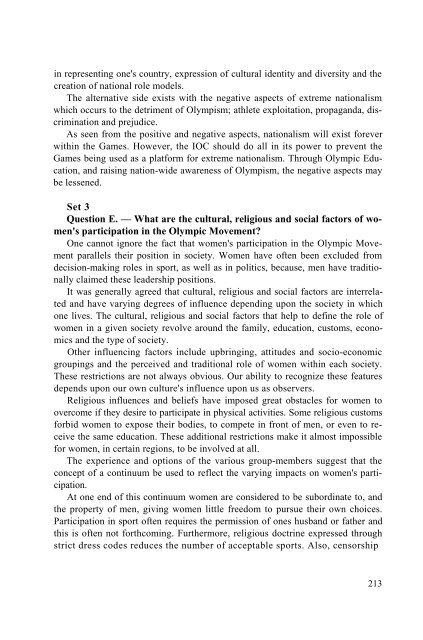You also want an ePaper? Increase the reach of your titles
YUMPU automatically turns print PDFs into web optimized ePapers that Google loves.
in representing one's country, expression of cultural identity and diversity and the<br />
creation of national role models.<br />
The alternative side exists with the negative aspects of extreme nationalism<br />
which occurs to the detriment of Olympism; athlete exploitation, propaganda, discrimination<br />
and prejudice.<br />
As seen from the positive and negative aspects, nationalism will exist forever<br />
within the Games. However, the IOC should do all in its power to prevent the<br />
Games being used as a platform for extreme nationalism. Through Olympic Education,<br />
and raising nation-wide awareness of Olympism, the negative aspects may<br />
be lessened.<br />
Set 3<br />
Question E. — What are the cultural, religious and social factors of women's<br />
participation in the Olympic Movement?<br />
One cannot ignore the fact that women's participation in the Olympic Movement<br />
parallels their position in society. Women have often been excluded from<br />
decision-making roles in sport, as well as in politics, because, men have traditionally<br />
claimed these leadership positions.<br />
It was generally agreed that cultural, religious and social factors are interrelated<br />
and have varying degrees of influence depending upon the society in which<br />
one lives. The cultural, religious and social factors that help to define the role of<br />
women in a given society revolve around the family, education, customs, economics<br />
and the type of society.<br />
Other influencing factors include upbringing, attitudes and socio-economic<br />
groupings and the perceived and traditional role of women within each society.<br />
These restrictions are not always obvious. Our ability to recognize these features<br />
depends upon our own culture's influence upon us as observers.<br />
Religious influences and beliefs have imposed great obstacles for women to<br />
overcome if they desire to participate in physical activities. Some religious customs<br />
forbid women to expose their bodies, to compete in front of men, or even to receive<br />
the same education. These additional restrictions make it almost impossible<br />
for women, in certain regions, to be involved at all.<br />
The experience and options of the various group-members suggest that the<br />
concept of a continuum be used to reflect the varying impacts on women's participation.<br />
At one end of this continuum women are considered to be subordinate to, and<br />
the property of men, giving women little freedom to pursue their own choices.<br />
Participation in sport often requires the permission of ones husband or father and<br />
this is often not forthcoming. Furthermore, religious doctrine expressed through<br />
strict dress codes reduces the number of acceptable sports. Also, censorship<br />
213

















